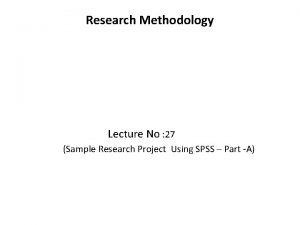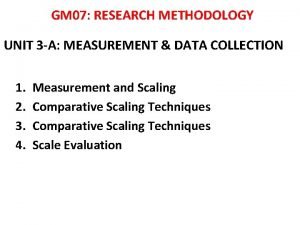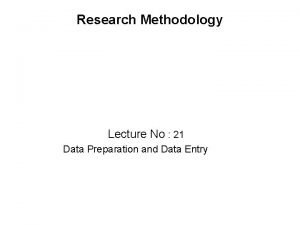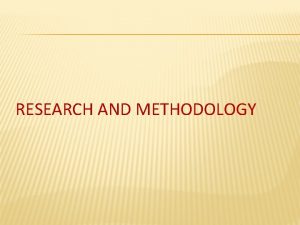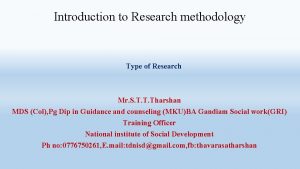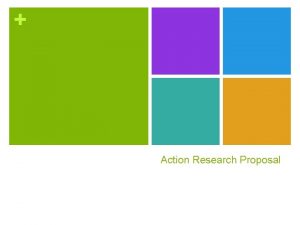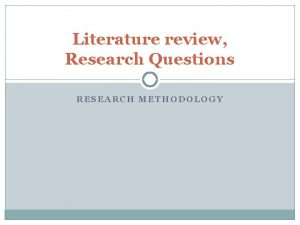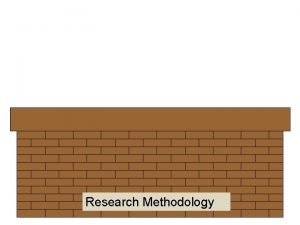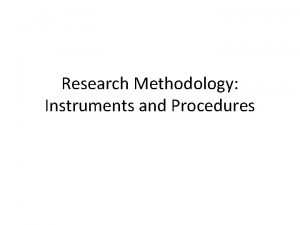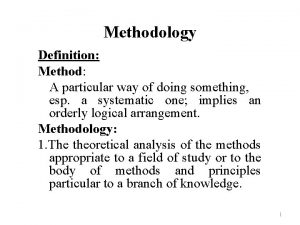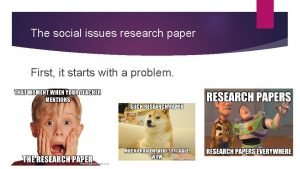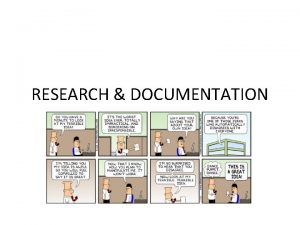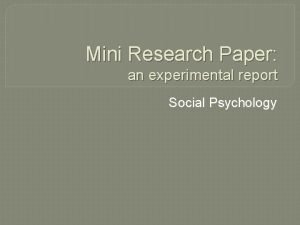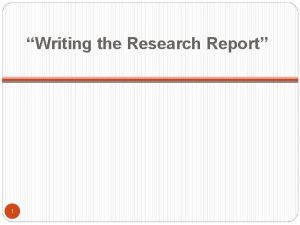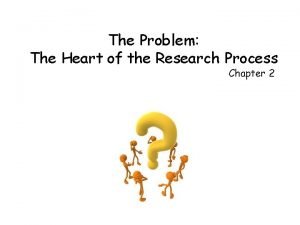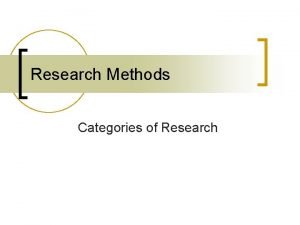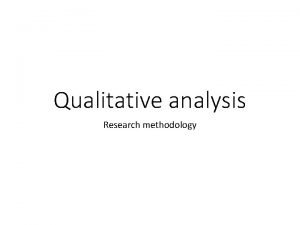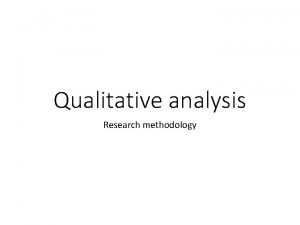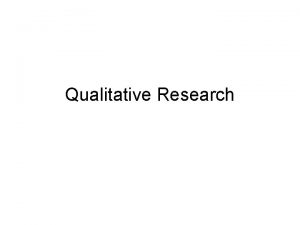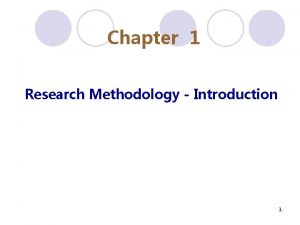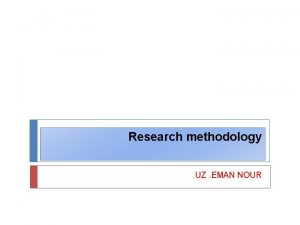Paper III Qualitative research methodology What is qualitative


























































































































- Slides: 122

Paper III Qualitative research methodology

What is qualitative research? v Qualitative research is designed to reveal a target audience’s range of behavior and the perceptions that drive it with reference to specific topics or issues. v It uses in-depth studies of small groups of people to guide and support the construction of hypotheses. The results of qualitative research are descriptive rather than predictive.

Why does qualitative research work? Several unique aspects of qualitative research contribute to rich, insightful results: v. Interaction among respondents, as they build on each other’s comments and ideas. v. The dynamic nature of the interview or group discussion process, which engages respondents more actively than is possible in more structured survey. v. The opportunity to probe ("Help me understand why you feel that way") enabling the researcher to reach beyond initial responses and rationales.

Why does qualitative research work? v The opportunity to observe, record and interpret non-verbal communication (i. e. , body language, voice intonation) as part of a respondent’s feedback, which is valuable during interviews or discussions, and during analysis. v The opportunity to engage respondents in "play" such as projective techniques and exercises, overcoming the self-consciousness that can inhibit spontaneous reactions and comments.

Why does qualitative research work? v Thus, it adds a human aspect to research that is not present in most quantitative data.

Objective 1. 1 Distinguish between qualitative and quantitative data?

From what we just learned and from reflecting on your previous IA, what differences do we initially see with Qualitative and Quantitative data?

Differences between qualitative and quantitative data? v Qualitative research explores attitudes, behavior and experiences through such methods as interviews or focus groups. v It attempts to get an in-depth opinion from participants. As it is attitudes, behavior and experiences which are important, fewer people take part in the research, but the contact with these people tends to last a lot longer. As the name suggest, it is quality over quantity.

Differences between qualitative and quantitative data? Qualitative research is concerned with developing explanations of social phenomena. That is to say, it aims to help us to understand the world in which we live and why things are the way they are. It is concerned with the social aspects of our world and seeks to answer questions about: v Why people behave the way they do v How opinions and attitudes are formed v How people are affected by the events that go on around them v How and why cultures have developed in the way they have v The differences between social groups

Differences between qualitative and quantitative data? Qualitative research is concerned with finding the answers to questions which begin with: why? how? in what way? This is usually open-ended in design. Quantitative research, on the other hand, is more concerned with questions about: how much? how many? how often? to what extent? This is usually closed-ended in design.

Characteristics of qualitative data v Qualitative research is concerned with the opinions, experiences and feelings of individuals producing subjective data. Hence the use of observations and interviews. What do we mean by subjective data? v Qualitative research describes social phenomena as they occur naturally. No attempt is made to manipulate the situation under study as is the case with experimental quantitative research. Most qualitative research is done in a natural setting. v Understanding of a situation is gained through a holistic perspective. Wheras Quantitative research depends on the ability to identify a set of variables.

Characteristics of qualitative data v Data are used to develop concepts and theories that help us to understand the social world. This is an inductive approach to the development of theory. Quantitative research is deductive in that it tests theories which have already been proposed Qualitative data are collected through direct encounters with individuals, through one to one interviews or group interviews or by observation. Data collection is time consuming. This can also be seen as a limitation to qualitative research.

Characteristics of qualitative data Different sampling techniques are used. In quantitative research, sampling seeks to demonstrate representativeness of findings through random selection of subjects. Qualitative sampling techniques are concerned with seeking information from specific groups and subgroups in the population. Criteria used to assess reliability and validity differ from those used in quantitative research

Terms associated with each research method Qualitative Research Quantitative Research Subjective Objective Holistic Reductionist Phenomenological Scientific Anti positivist Positivist Descriptive Experimental Naturalistic Contrived Inductive Deductive

Other differences between Qualitative and Quantitative data v Each of the various features of qualitative research may be viewed as a strength or as a weakness. This depends on the original purpose of the research. v For example, one common criticism levied at qualitative research is that the results of a study may not be generalizable to a larger population because the sample group was small and the subjects were not chosen randomly. v But the original research question may have sought insight into a specific subgroup of the population, not the general population because the subgroup is “special” or different from the general population and that specialness is the focus of the research.

Other differences between Qualitative and Quantitative data cont…. v The small sample may have been necessary because very few subjects were available such as is the case with some ethnic groups or patient groups suffering from a rare condition. v In such studies, generalizability of the findings to a wider, more diverse population is not an aim. v This is a very important fact regarding qualitative data.

Questions about 3. 1?

Objective 1. 2 Explain strengths and limitations of a qualitative approach to research?

Note: You must explain all of the strengths and limitations that you list.

What does the command term require us to do?

Strengths of Qualitative Data Useful for studying a limited number of cases in depth (such as cultural bound syndromes). Useful for describing complex phenomena (the rise of ADHD cases in Western teen females). v Can conduct cross-case comparisons and analysis (such as BN in males and females). v Provides understanding and description of people’s personal experiences of phenomena (i. e. , the emic or insider’s viewpoint). v Can describe in rich detail phenomena as they are situated and embedded in local contexts(western etiologies of depression).

Other Strengths of Qualitative Data…. . It enables more complex aspects of a persons experience to be studied. Fewer restriction or assumptions are placed on the data to be collected. For example, if I measure depression by asking ten 1 -7 scale questions, I can only collect data on these ten things I’m asking about Not everything can be quantified, or quantified easily, and an advantage of qualitative research is that it can investigate these things (for example, individual experiences). Why is it important to account for individual differences in research?

Limitations of Qualitative Data v Knowledge produced might not generalize to other people or other settings (i. e. , findings might be unique to the relatively few people included in the research study). v It is difficult to make quantitative predictions. Why is this? v It is more difficult to test hypotheses and theories with large participant pools. Why is this?

Limitations of Qualitative Data It generally takes more time to collect the data when compared to quantitative research. Give examples. v Data analysis is often time consuming. Give examples of why. v The results are more easily influenced by the researcher’s personal biases and characteristics. How so? v

Objective 1. 3 To what extent can findings be generalized from qualitative studies?

Note: This questions invites you to either discuss the merit or lack thereof of generalizability within qualitative research.

The Generalizability of Qualitative Research…. . Or the lack thereof Despite the many positive aspects of qualitative research, studies continue to be criticized for their lack of objectivity and generalizability. What do we mean by objectivity? Explain this to the reader. What do we mean by generalizability? Explain this to the reader.

Is it possible to generalize with qualitative data? v The term generalizability is defined as the degree to which the findings can be applied to the entire population. It is a key goal of most psychological research. v BUT qualitative research is often criticized for its lack of objectivity and generalizability. There are two things to consider; 1. Generalizability is not important to qualitative research 2. Certain types of generalizability may apply.

1. Generalizability is not important to qualitative research

2. Certain types of generalizability may apply. v Qualitative studies are not generalizable in the traditional sense of the word, nor do they claim to be. They have other redeeming features which makes them highly valuable in the education community. v Partial generalizations may be possible to similar populations, but even this should not be a primary concern of qualitative research.

Generalizing from case studies. In general, case studies; v Can’t be generalized to other populations (i. e. unless confirmed from other studies) v May be used for inferential generalization-If findings can be transferred to another setting. v Can have theoretical generalization-If further research finds similar patterns.

Generalizing from case studies. v Problems related to sampling and generalizations may have little relevance to the goals of the study and the reality of the situation.

2. Certain types of generalizability may apply. v The goal of a study may be to focuses on a selected contemporary phenomenon such as child abuse or addiction where in-depth descriptions would be an essential component of the process. v In such situations, small qualitative studies can gain a more personal understanding of the phenomenon and the results can potentially contribute valuable knowledge to the community.

Questions/comments?

Objective 1. 4 Discuss ethical considerations in qualitative research?

First things first, what are ethical considerations? This should be discussed in your essay.

Ethical Considerations Ethics are codes or rules which govern that practices of a research study. It dictates how information, and participant relationships should be managed. Code of ethics and the laws are mutually exclusive. An action may be legal but unethical. However some acts are both illegal and unethical. Ethical considerations occur when you are required to use these rules to better serve your participant in your research study.

All researchers are responsible for ensuring that participants Are well-informed about the purpose of the research they are being asked to participate in Understand the risks they may face as a result of being part of the research Understand the benefits that might accrue to them as a result of participating Feel free to make an independent decision without fear of negative consequences

Issues in Qualitative Research Protection of participants through the informed consent process favors formalized interaction between researcher and participant. Strength of qualitative research methods often lies in the informality of the communication as well as the iterative nature of the research process. How can we reconcile these two conflicting dynamics?

Four ethical considerations relevant to the unstructured features of qualitative research. 1. 2. 3. 4. Informed consent from all participants is required. Anonymity and confidentiality are guaranteed. Participants are protected from potential harm. Researchers are protected from potential harm.

Informed consent (APA , 2011) v Purpose of the study The aim of your interview, case study, etc. v Everything the participant is required to do. A step by step breakdown of what you want the participant to do. v Potential risks and benefits from participation What are the possible threats that your participant may face? v Any situation where participants might be identified or quoted. v Voluntary participation Participation must always be voluntary. v Any anticipated factors that might influence a person’s decision to participate.

Informed consent (APA , 2011) cont. v Any possible consequences of leaving the study before it ends. Loss of inducement, etc. v Any inducements for participation (such as pay) v How the data will be used. v How to contact someone to find out the results of the study. v Permission from parents for minors

Confidentiality and Anonymity v Confidentiality and anonymity are related but distinct concepts. v The Concise Oxford Dictionary defines confidentiality as: ‘spoken or written in confidence; charged with secrets’ while anonymity is defined as: ‘of unknown name, of unknown authorship’.

Confidentiality and Anonymity v To assure someone of confidentiality means that what has been discussed will not be repeated, or at least, not without permission. v The notion of confidentiality (and anonymity) is invariably raised and discussed with research participants prior to their participation in research. v These issues are usually discussed in the informed consent form.

Confidentiality and Anonymity v In the research context, confidentiality (as it is commonly understood) makes little sense. v Confidential research cannot be conducted; researchers have a duty to report on the findings of their research and they cannot do so if the data they collect is confidential (i. e. cannot be revealed).

Confidentiality and Anonymity v What researchers can do is to ensure they do not disclose identifiable information about participants and to try to protect the identity of research participants through various processes designed to anonymize them. v The extent to which anonymization is successful varies according to the research context. In this respect confidentiality cannot be assured; researchers can claim that they will endeavor to ensure to the best of their ability that participants are not able to be identified but they cannot promise that this will be the case.

Objective 1. 5 Discuss sampling techniques appropriate to qualitative research?

Sampling in Qualitative Research Even if it were possible, it is not necessary to collect data from everyone in a community in order to get valid findings. In qualitative research, only a sample (that is, a subset) of a population is selected for any given study. The study’s research objectives and the characteristics of the study population (such as size and diversity) determine which and how many people to select.

Sampling in Qualitative Research We will discuss three of the most common sampling methods used in qualitative research: 1. Purposive sampling 2. Quota sampling, and 3. Snowball sampling.

What is purposive sampling? Purposive sampling, one of the most common sampling strategies, groups participants according to preselected criteria relevant to a particular research question (for example, Minority women in the IB program).

What is purposive sampling? Sample sizes, which may or may not be fixed prior to data collection, depend on the resources and time available, as well as the study’s objectives. This is something that is subjective to each individual research study.

What is purposive sampling? Purposive sample sizes are often determined on the basis of theoretical saturation (the point in data collection when new data no longer bring additional insights to the research questions). Purposive sampling is therefore most successful when data review and analysis are done in conjunction with data collection.

Advantages of purposive sampling? Those people who are unsuitable for the sampling study or who do not fit the bill have already been eliminated, so only the most suitable candidates remain. As the most appropriate people for the study have been selected, this process becomes a lot less time consuming.

Advantages of purposive sampling? With fewer time constraints and a more accurate subject, the costs for carrying out the sampling project are greatly reduced. The results of purposeful sampling are usually expected to be more accurate than those achieved with an alternative form of sampling. If you are looking for a very rare or much sought after group of people for a particular research study, using purposive sampling may usually be the only way you can track them down.

Advantages of purposive sampling? Quite often market researchers use this type of sampling in order to target a particular group of people. Basing their results on what this group has said, their findings will then be used as a representation of the rest of the population. Deciding in advance what group to target based on the types of results a company is expecting to find will help them save costs and get the job done as soon as possible.

Limitations of purposive sampling Purposive samples can be highly prone to researcher bias. The idea that a purposive sample has been created based on the judgment of the researcher is not a good defense when it comes to alleviating possible researcher biases, especially when compared with probability sampling techniques that are designed to reduce such biases.

Limitations of purposive sampling? However, this judgmental, subjective component of purpose sampling is only a major disadvantage when such judgments are ill-conceived or poorly considered; that is, where judgments have not been based on clear criteria, whether a theoretical framework, expert elicitation, or some other accepted criteria.

Example of purposive sampling… A researcher wants to get opinions from non-working mothers. They go around an area knocking on doors during the day when children are likely to be at school. They ask to speak to the 'woman of the house. Their first questions are then about whethere are children and whether the woman has a day job.

What is quota sampling? In quota sampling the selection of the sample is made by the interviewer, who has been given quotas to fill from specified sub-groups of the population. For example, an interviewer may be told to sample 50 females between the age of 45 and 60.

What is quota sampling? There are similarities with stratified sampling, but in quota sampling the selection of the sample is also nonrandom. The main reason why researchers choose quota samples is that it allows the researchers to sample a subgroup that is of great interest to the study. If a study aims to investigate a trait or a characteristic of a certain subgroup, this type of sampling is the ideal technique. When would this be necessary?

What is quota sampling? Quota sampling also allows the researchers to observe relationships between subgroups. In some studies, traits of a certain subgroup interact with other traits of another subgroup. In such cases, it is also necessary for the researcher to use this type of sampling technique. What are examples of these types of interactions?

EXAMPLE OF QUOTA SAMPLES In a study wherein the researcher likes to compare the academic performance of the different high school class levels, its relationship with gender and socioeconomic status, the researcher first identifies the subgroups. Usually, the subgroups are the characteristics or variables of the study. The researcher divides the entire population into class levels, intersected with gender and socioeconomic status. Then, he takes note of the proportions of these subgroups in the entire population and then samples each subgroup accordingly.

DISADVANTAGES OF QUOTA SAMPLES It may appear that this type of sampling technique is totally representative of the population. In some cases it is not. Keep in mind that only the selected traits of the population were taken into account in forming the subgroups. How could this lead to researcher bias?

DISADVANTAGES OF QUOTA SAMPLES I In the process of sampling these subgroups, other traits in the sample may be overrepresented. In a study that considers gender, socioeconomic status and religion as the basis of the subgroups, the final sample may have skewed representation of age, race, educational attainment, marital status and a lot more. For example, a sample of African American seniors in the IB program may give you a skewed representation of African American females from middle class homes. How can this be a limitation?

What is snowball sampling? Snowball sampling is a non-probability sampling technique that is used by researchers to identify potential subjects in studies where subjects are hard to locate.

What is snowball sampling? Researchers use this sampling method if the sample for the study is very rare or is limited to a very small subgroup of the population. This type of sampling technique works like chain referral. After observing the initial subject, the researcher asks for assistance from the subject to help identify people with a similar trait of interest.

What is snowball sampling? The process of snowball sampling is much like asking your subjects to nominate another person with the same trait as your next subject. The researcher then observes the nominated subjects and continues in the same way until the obtaining sufficient number of subjects. When can this type of sampling be useful?

When is snowball sampling useful? If obtaining subjects for a study that wants to observe a rare disease, the researcher may opt to use snowball sampling since it will be difficult to obtain subjects. It is also possible that the patients with the same disease have a support group; being able to observe one of the members as your initial subject will then lead you to more subjects for the study. Snowball sampling is often used with focus groups in qualitative research methods.

Advantages of snowball technique… The chain referral process allows the researcher to reach populations that are difficult to sample when using other sampling methods. The This process is cheap, simple and cost-efficient. sampling technique needs little planning compared to other sampling techniques.

Limitations of snowball technique… The researcher has little control over the sampling method. The subjects that the researcher can obtain rely mainly on the previous subjects that were observed. Representativeness of the sample is not guaranteed. The researcher has no idea of the true distribution of the population and of the sample.

Limitations of snowball technique… Sampling bias is also a fear of researchers when using this sampling technique. Initial subjects tend to nominate people that they know well. Because of this, it is highly possible that the subjects share the same traits and characteristics, thus, it is possible that the sample that the researcher will obtain is only a small subgroup of the entire population.

Questions/Concerns?

Objective 1. 6 Explain effects of participant expectations and researcher bias in qualitative research.

Research Bias Research bias, also called experimenter bias, is a process where the researcher performing the research influence the results, in order to portray a certain outcome.

Research Bias Some bias in research arises from experimental error and failure to take into account all of the possible variables. Other research bias arises when researchers select subjects that are more likely to generate the desired results, a reversal of the normal processes governing science. This is often the case with qualitative research.

Research Bias Research bias is the one factor that makes qualitative researc much more dependent upon experience and judgment than quantitative research. Quantitative Research Bias: Denial of any Research Bias Qualitative Research Bias: Acceptance and Acknowledgment of Research Bias. For example, when using social research subjects, it is far easi become attached to a certain viewpoint, jeopardizing impartialit

Research Bias INTERVIEWER BIAS This is one of the most difficult research biases to avoid in many qualitative experiments when relying upon interviews. With interviewer bias, the interviewer may subconsciously give subtle clues in with body language, or tone of voice, that subtly influence the subject into giving answers skewed towards the interviewer’s own opinions, prejudices and values. What are potential examples of this with interviews?

Participant expectations/The Hawthorne effect Participant expectation or the Hawthorne effect is the process where subjects of an experiment change their behavior, simply because they are being studied. This is one of the hardest inbuilt biases to eliminate or factor into the design. This has been seen in interviews, case studies, and naturalistic observations. (You can choose one research method to explain).

Participant expectations/The Hawthorne effect Many types of research use human research subjects, and the Hawthorne effect is an unavoidable bias that the researcher must try to take into account when they analyze the results. Subjects are always liable to modify behavior when they are aware that they are part of a study, and this is extremely difficult to avoid. All that a researcher can do is attempt to factor the effect into the research design, a tough proposition, and one that makes social research a matter of experience and judgment.

Hawthorne effect in case studies/overt observations Mayo’s and Landsberger’s work became one of the foundations of a field of social science known as Industrial Psychology. Academics in this field understand that interpersonal factors and the dynamic social relationships between groups must be assessed when performing any type of social analysis. If a group is isolated from their work colleagues, for the purpose of research, the individual attention and the normal human instinct to feel ‘chosen, ’ will skew the results.

Hawthorne effect in case studies/overt observations Overt observation involves: the researcher being open about the reason for her presence in the field of study since the researcher is given permission by the group to conduct her research. Explain how this can effect the behavior of the participant?

Hawthorne effect and treatment Overt observation involves: the researcher being open about the reason for her presence in the field of study since the researcher is given permission by the group to conduct her research. Explain how this can effect the behavior of the participant?

Questions/Concerns?

Objective 1. 7 Explain the importance of Credibility in Qualitative Research.

Trustworthiness in qualitative research. Because of the subjective nature of qualitative methods, researchers have looked to develop ways in which trustworthiness can be applied to this type of research E. G. Guba (1981) has investigated the trustworthiness of naturalistic inquiries.

Trustworthiness in qualitative research. The aim of trustworthiness in a qualitative inquiry is to support the argument that the inquiry’s findings are “worth paying attention to” (Lincoln & Guba, 1981, p. 290). This is quite different from the conventional experimental (quantitative) precedent of attempting to show validity, soundness, and significance.

Trustworthiness in qualitative research. In any qualitative research project, four issues of trustworthiness demand attention: credibility, transferability, dependability, and confirmability. For this objective, we will only explain credibility (although it is important to note to the reader that credibility is one of four ways of ensuring trustworthiness)

What is credibility? Credibility refers to the objective and subjective components of the believability of the research study. In other words, it is a measure of how well the inquiry’s findings are supported by the data collected.

Credibility in research Credibility is an issue for all forms of research, yet it can be thought about and achieved in different ways. How a researcher establishes credibility is based on the epistemological assumptions guiding the research.

Credibility in research One of the key criteria addressed by quantitative researchers is that of internal validity, in which they seek to ensure that their study measures or tests what is actually intended. According to Merriam, the qualitative investigator’s equivalent concept, i. e. credibility, deals with the question, “How congruent are the findings with reality? ”

Clearing the air External validity (transferability) How well does your findings compare to the real world? Internal validity (credibility) How well does your study compare to the real world?

Importance of credibility Lincoln and Guba (1981) argue that ensuring credibility is one of most important factors in establishing trustworthiness. The assumption is if your research is not credible (internally valid) it cannot be transferable (externally valid)

Example Mr. Freeman is examining Minor Depressive Disorder in Rickard’s High School seniors. His director has given him a 30 senior quota to interview and survey. To save time, he interviews his 2 nd period class (because they are all seniors). He interviews them during the month of April and discovers high levels of MDD symptoms in this class. He uses this data for his research. How is this internally invalid? How does this effect the external validity of my findings?

Questions/Concerns? .

Objective 1. 8 Explain the effect of triangulation on the credibility/trustworthiness of qualitative research

What is triangulation? Triangulation is a powerful technique (one that I personally endorse) that facilitates validation of data through cross verification from more than two sources. In particular, it refers to the application and combination of several research methodologies in the study of the same phenomenon.

Types of triangulation N. K. Denzin (1978) identified four basic types of triangulation: Data triangulation: involves time, space, and persons Investigator investigation triangulation: involves multiple researchers in an Theory triangulation: involves using more than one theoretical scheme in the interpretation of the phenomenon * Methodological triangulation: involves using more than one method to gather data, such as interviews, observations, questionnaires, and focus groups.

Types of triangulation Denzin drew a distinction between withinmethod and between-method triangulation. The former involves the use of varieties of the same method to investigate a research issue; for example, semi‑structured, focus group and narrative interviews.

Types of triangulation Between-method triangulation involved contrasting qualitative research methods, such as a interview and observation. However, sometimes this meaning of triangulation is taken to include the combined use of QUANTITATIVE RESEARCH and QUALITATIVE RESEARCH. Note: These methods usually compliment each other…

Types of triangulation Many contemporary psychologist reserve the term for those specific occasions in which researchers seek to check the validity of their findings by cross-checking them with another method.

Let’s start with a real life example of triangulation. My own research projects have included: • Interviews (face-to-face or phone as needs be) • Case studies (aka diary study) • Focus groups (student to student and parent to student) • Secondary research (including an examination of school research data) • Quantitative survey (to help validate findings with a much larger sample size) • A meta-analysis (of existing product or early concepts) What are the positive effects of using multiple methods? Explain this to the reader

Positive effects of triangulation: Many different perspectives (credibility) lots of data! Each method is used in a way which is appropriate for it, and when combined they allow a degree of cross checking. This allows for the reader of the research to begin to find credibility in your research (independent from your personal biases).

How triangulation effects trustworthiness Triangulation, when properly used, can reduce the effect of researcher bias-which in turn increases credibility of research. Explain this to the reader. Provide an example. Triangulation, when used with qualitative and quantitative method, can increase the external validity of your research. Explain this to the reader. Provide an example.

How triangulation effects trustworthiness The positive effects of triangulation can include: Increasing confidence in research data Creating innovative ways of understanding a phenomenon. Challenging or integrating theories Providing a clearer understanding of the problem (Jick, 1979). These benefits are subjective to each type of triangulation method used.

How triangulation effects trustworthiness Between method triangulation may help to explain the success of interventions when the numbers fail to answer the question(Polit & Hungler, 1995). In other words, Between method triangulation has the potential of exposing unique differences or meaningful information that may have remained undiscovered with the use of only one approach or data collection technique in the study.

How triangulation effects trustworthiness Hinds (1989) said combining qualitative and quantitative methods “increases the ability to rule out rival explanations of observed change and reduces skepticism of change-related findings”. In a study of adolescent hopefulness, she incorporated both methods and found the qualitative results obtained from asking structured questions validated the quantitative information gathered from the Hopefulness Scale for Adolescents (HAS).

How triangulation effects trustworthiness She emphasized that using the two approaches together helped interpret the process of change in adolescent hopefulness (Hinds, 1989). This increased the transferability of her study.

How triangulation effects trustworthiness It is important to note, however, that the use of triangulation strategies does not strengthen a flawed study. Why is the case? Provide an example. Researchers should use triangulation if it can contribute to understanding the phenomenon; however, they must be able to articulate why the strategy is being used and how it might enhance the study.

How triangulation effects trustworthiness It is also important to note that you can never rule out bias or preconceptions but you should be cognizant of their presence and potential impact. In fact, failing to recognize bias is itself is known as “design bias” (which also includes failing to disclose assumptions and possible bias when reporting your findings).

How triangulation effects trustworthiness Particularly with qualitative research, it is considered best practice to acknowledge bias and preconceptions. This is what Contemporary Psychologist refer to as “reflexivity”.

Questions/Concerns? .

Objective 1. 9 Explain reflexivity in qualitative research

What is reflexivity? What does it mean to be reflexive Reflexivity requires an awareness of the researcher's contribution to the construction of meanings throughout the research process, and an acknowledgment of the impossibility of remaining 'outside of' one's subject matter while conducting research. (Hollar, 2009). How could you put this in your own words? Reflexivity then, urges us "to explore the ways in which a researcher's involvement with a particular study influences, acts upon and informs such research. " (Nightingale and Cromby, 1999).

What is reflexivity? What does it mean to be reflexive Qualitative research requires reflexivity on the part of the researcher. By this is we mean that as a researcher, you need to reflect on the nature of your involvement in the research process, and the way this shapes its outcomes. What are the ways that your personal involvement in the research effect the outcome in qualitative research (specific examples)

What is reflexivity? What does it mean to be reflexive There are two types of reflexivity: personal reflexivity and epistemological reflexivity. Personal reflexivity involves reflecting upon how situational and dispositional factors (your own values, experiences, interests, beliefs, political commitments, social identities) have shaped the research. How can dispositional factors impact Qualitative research? How can situational factors influence qualitative research.

Epistemological reflexivity attempts to identify the foundations of knowledge and the implications of any findings. It requires us to engage with questions such as: How has the research question defined and/or limited what can be 'found’? What are examples of this? How has the design of the study and the method of analysis 'constructed' the data and the findings? What are examples of this? How could the research question have been investigated differently? Does your personal knowledge (or lack thereof) influence what you look for? How?

What is reflexivity? What does it mean to be reflexive Since the researcher is the primary “instrument” of data collection and analysis, reflexivity is deemed essential (Glesne, 1999; Merriam, 1998; Russell & Kelly, 2002; Stake, 1995). Experts contend that through reflexivity, qualitative researchers may become aware of what allows them to see, as well as what may inhibit their seeing (Russell & Kelly).

How are researchers reflexive? The Research Diary: A Place for Recording Reflections and developing reflexivity Keeping a research diary is an essential part of undertaking qualitative research. It is useful to separate this into four sections in the order that you are prompted to reflect on different aspects of doing research and your role within the construction of research knowledge (Blaxter, Hughes and Tight, 2001):

How are researchers reflexive? 1. Observational Note This is a descriptive note of an event such as an interview, chance encounter, observation. They contain as little interpretation as possible and are as reliable as you can construct them. 2. Methodological Note This is the place where you reflect on the methodological aspects of research and your actions in undertaking an interview, observation and so forth. How did the interview go? What was your role within it?

How are researchers reflexive? 3. Theoretical Note It is here that you begin to make meaning about your data. What are your initial explanations? What is your data telling you? 4. Analytical Memo This is the place where you are trying to bring several inferences together. You might, for example, review your theoretical notes and begin to see patterns or recurrent themes in your data. You would also attempt to link your analysis to the literature in your field.

Conclusion on reflexivity Learning to reflect on your behavior and thoughts, as well as on the phenomenon under study, creates a means for continuously becoming a better qualitative researcher. Becoming a better researcher captures the dynamic nature of the process. Conducting research, like teaching and other complex acts, can be improved; it cannot be mastered. (Glesne & Peshkin, 1992, p. xiii)

Questions/Concerns? .
 Methodology examples
Methodology examples Ocjs grants
Ocjs grants Methodology in research paper
Methodology in research paper Example of methodology section of research paper
Example of methodology section of research paper Comparative scaling techniques in research methodology
Comparative scaling techniques in research methodology Component of research methodology
Component of research methodology Hamlet act iii scene iii
Hamlet act iii scene iii What is background of the study
What is background of the study Qualitative research design
Qualitative research design Qualitative research methods
Qualitative research methods Qualitative research
Qualitative research Methodology in concept paper
Methodology in concept paper Qualitative and quantitative data analysis
Qualitative and quantitative data analysis Objective of research problem
Objective of research problem What are variables in research methodology
What are variables in research methodology Objectives of research methodology
Objectives of research methodology Research methodology flow chart
Research methodology flow chart How to write methodology in research proposal
How to write methodology in research proposal Good measurement
Good measurement What is the time dimension of the study
What is the time dimension of the study Method vs methodology
Method vs methodology Central editing in research methodology
Central editing in research methodology Research methodology lecture
Research methodology lecture Continuous variable example
Continuous variable example What is independent variable in research
What is independent variable in research Research methodology meaning
Research methodology meaning Ftpay
Ftpay 5 stages in research
5 stages in research Data collection procedures
Data collection procedures Design research methodology
Design research methodology Types of research methodology
Types of research methodology Method
Method Example of research proposal cover page
Example of research proposal cover page Ocar structure
Ocar structure Confounded relationship in research methodology
Confounded relationship in research methodology Research methods notes kenyatta university
Research methods notes kenyatta university Midterm exam for applied research methods
Midterm exam for applied research methods Methology
Methology Methodology in research
Methodology in research Design research definition
Design research definition Research methodology chapter 4
Research methodology chapter 4 Engineering research methodology
Engineering research methodology Research design example
Research design example True or false questions on research methodology
True or false questions on research methodology Research methodology in applied economics
Research methodology in applied economics Field research techniques
Field research techniques Pantry audits
Pantry audits Exploratory verbs in qualitative research
Exploratory verbs in qualitative research Common sense in research methodology
Common sense in research methodology Quantitative purpose statement
Quantitative purpose statement Research tradition examples
Research tradition examples Legal research methodology
Legal research methodology Definition of terms in research
Definition of terms in research Qualitative research methods
Qualitative research methods Research methodology
Research methodology Research methodology definition
Research methodology definition Research methodlogy
Research methodlogy Methodology example in research proposal
Methodology example in research proposal Methodology
Methodology Expost facto research design
Expost facto research design Aice english paper 2
Aice english paper 2 Hand approach general paper
Hand approach general paper Qualitative paper example
Qualitative paper example Abstract and keywords example
Abstract and keywords example What is the purpose of a research paper
What is the purpose of a research paper Miguel is writing a research paper
Miguel is writing a research paper Social issues for research paper
Social issues for research paper How to make a source card for a website
How to make a source card for a website Format of investigatory project
Format of investigatory project What is an abstract in science fair
What is an abstract in science fair Research paper body paragraph outline
Research paper body paragraph outline Source title of a book
Source title of a book 5 parts of a research paper
5 parts of a research paper Notecards for research paper
Notecards for research paper Example body paragraph research paper
Example body paragraph research paper How to write an a+ research paper keystone
How to write an a+ research paper keystone Documentation in research paper
Documentation in research paper What are the four parts of a body paragraph
What are the four parts of a body paragraph Title page mla 8
Title page mla 8 Mla format example
Mla format example Research paper rough draft
Research paper rough draft Order of a body paragraph
Order of a body paragraph Research topic
Research topic Mla style outline
Mla style outline Why we all have
Why we all have Serial killer project forensics
Serial killer project forensics Cfrogc
Cfrogc Example note cards for a research paper
Example note cards for a research paper How to write a career research paper
How to write a career research paper Source cards for research paper
Source cards for research paper Outline research paper
Outline research paper Affiliation in research paper
Affiliation in research paper Action research project examples
Action research project examples Research paper presentation example
Research paper presentation example Concept paper meaning
Concept paper meaning Research paper requirements
Research paper requirements Word module 2 creating a research paper
Word module 2 creating a research paper Experimental research report
Experimental research report Mla citing a picture
Mla citing a picture Technical abstract example
Technical abstract example Concept paper
Concept paper Which information goes on a source card?
Which information goes on a source card? Mitch is writing a research paper on the motifs
Mitch is writing a research paper on the motifs The cars model
The cars model Junior research paper examples
Junior research paper examples Multi genre topics
Multi genre topics Parts of research paper
Parts of research paper Example of participants section in research paper
Example of participants section in research paper How to write a summary of a research paper
How to write a summary of a research paper Significance of the study
Significance of the study Definition of terms in research example format
Definition of terms in research example format Example of scope of the study in thesis
Example of scope of the study in thesis Research paper on silent sound technology
Research paper on silent sound technology Example of conclusion in research
Example of conclusion in research Categories of research design
Categories of research design Input-process-output model in research example
Input-process-output model in research example Micro electronic pill research paper
Micro electronic pill research paper Hypothesis research paper example
Hypothesis research paper example Conclusion sample in research
Conclusion sample in research Research paper outline example
Research paper outline example Simon peyton jones how to write a great research paper
Simon peyton jones how to write a great research paper Simon peyton jones how to write a great research paper
Simon peyton jones how to write a great research paper Research paper on greek mythology
Research paper on greek mythology
